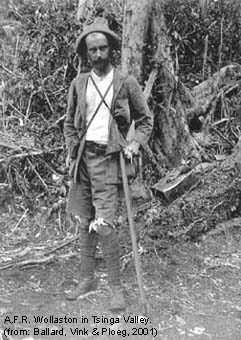

Papua-Insects.nl
The Papua Insects Foundation
The second English South New Guinea Expedition or Wollaston Expedition (1912-1913)
This was one of the most important expeditions in the zoological and botanical history for Papua Indonesia. Its primary goal was to reach the top of Mount Carstensz (Mount Jaya). The competition with the Dutch to reach the top was an important motivation to finance the expensive expedition of A.F.R. Wollaston which had not less than 225 expedition members (of which 132 men of a Dutch military escort!). The wealthy Rothschild family was one of the major financiers and it is therefore not surprising that many new insect species were described by L.W. Rothschild.
The expedition started in September 1912 and mainly followed the Oetakwa (Utakwa) River and Setakwa River at the south side of the Snow Mountains. At 30 January they reached the snow, but they were not able to reach the top for only 400 meters! Wollaston's disappointment was enormous and the expedition's toll was hard. About 30-40 accompanying Amungme Papuas had died on the way. Wollaston reports in his diary as follows:
"From No. 6 Camp down to No. 3 Camp was a walk that I shall remember as long as I live. Soon after starting we came on the body of a man not long dead, then the bodies of two women, one child and another man. On further, many more bodies lying in ones and twos - some dead on the track - some in rock shelters, and some in roughly made huts of leaves; one or two had been burried, but most were left just where they lay. All this had happened in the last three weeks, for these bodies were along the same ground we had passed three weeks earlier."
Until now it is not clear what caused the death of so many Papuas, but Wollaston assumed that a combination of the unusual cold environment for the Papuas and probably Malaria must have been responsible.
Several camps (bivak) were made of which only a few got names, the rest got numbers from Camp 1 to Camp 14 (sequence of the voyage) (note that the altitudes are in feet):
Wollaston lost most of his equipment (fortunately not his collection) and his original diary by capsizing of his canoe on the way to Base Camp. He left New Guinea on 3 April 1913. He had plans to return for a third expedition but the First World War came in the way and he never returned to New Guinea again.
Literature
Ballard, Ch., S. Vink & A. Ploeg, 2001. Race to the Snow. Photography and the exploration of Dutch New Guinea, 1907-1936: 96 pp. Royal Tropical Institute, Amsterdam.